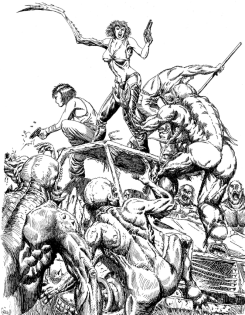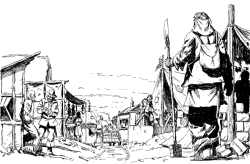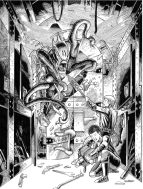So what is Other Dust?
 Other Dust is a Post Apocalyptic, OSR Roleplaying game made by Sine Nomine. It’s part of the family of RPGs made by Sine Nomine which are all mechanically compatible with each other. The setting itself is based on Earth (although you could set it elsewhere if you prefer) and ties in with the Stars Without number setting, but earlier after the “Scream”, a Galactic wide event that killed or drove mad Psychics at the height of the “Terran Mandate”.
Other Dust is a Post Apocalyptic, OSR Roleplaying game made by Sine Nomine. It’s part of the family of RPGs made by Sine Nomine which are all mechanically compatible with each other. The setting itself is based on Earth (although you could set it elsewhere if you prefer) and ties in with the Stars Without number setting, but earlier after the “Scream”, a Galactic wide event that killed or drove mad Psychics at the height of the “Terran Mandate”.
Sadly however, the Terran Mandate became dependent on Psychics to control vast jumpgates to transport ships/people many light years across the galaxy. In addition to that, there were also very powerful AI controlling swarms of Nanites on planets, space stations, ships etc, whose purpose was to keep the citizens of the Terran Mandate healthy and happy, by curing wounds, sicknesses, ensure happiness and so on.
What made this worse is the leaders of the Terran Mandate, known as “Directors” are also VERY powerful Psychics driven mad by “The Scream”, attacked the guardian AIs, that are knows as “Maestros” that the Directors had originally created to manage the vast Nanite swarms that cared for it’s citizens in the Terran Mandate.
A war took place between the powerful AIs and the maddened Psychics, many on both sides being destroyed or corrupted in some way. The surviving AIs, most of which had their programming corrupted and twisted by the Psychic/AI wars, the rest of the citizenry caught in the middle.
Thus the Terran Mandate collapsed into a Dark age……. Planets, Sectors and Systems cut off from each other for 100s of years…
The worst of this took place on the Home planet Earth. More than one of the Directors were based on Earth and the most powerful AI were also based there, managing the all powerful Nanite swarms that nurtured the citizens on Earth and Earth itself. In addition to that, Earth had a protective “Mirror Shield” made up of 1000s of defense satellites, stopping access access to and from Earth, also controlled by the Maestros..
The Directors were killed, suppressed or driven off, however the Maestros were also driven mad by the war and now 100s of years later, do their best to maintain order on Earth, blocking off access to and from Earth, however the wars, radiation, malfunctioning Nanite Swarms, insane Psychics have corrupted the Landscape, the Planet, the people, animals, plant life, ecology…. everything.

Now Earth is a ruin, a Post Apocalyptic world, a shadow of it’s former self, a mutated, twisted, perverted version of it’s past…. This is the setting for Other Dust…. where only the strong and/or clever survive to rise in the ashes of the past on the ruin of Planet Earth….
OSR Roleplaying

Other dust is an OSR roleplaying game. The term OSR, is an abbreviation for “Old School Renaissance”. OSR means different things to different people. But one thing that is generally agreed on is it’s a style of Roleplaying game that is based on Roleplaying games from the beginning of Roleplaying games. In many cases it refers to the Original Dungeons and Dragons published by Gary Gygax in the 1970s.
Other Dust, Stars Without number and other Sine Nomine games are based on OSR rules, specifically the Original Dungeons and Dragons rules. However it has been converted to a Scifi/Post Apocalyptic rules set. It also has other enhancements, such as a Skill system and other features to make it suitable for the genre.
Sandbox Roleplaying
Sandbox Roleplaying games compared to other types of Roleplaying games generally don’t have an overall plot or major quest to be followed. They offer a lot of freedom for players to just do what they want and often it involves exploring and pursuing their own goals.
As a GM (Game Master) a lot of the content is randomly generated and fleshed out as the campaign progresses, whereas often in other Tabletop RPGs, the GM uses a published adventure or campaign.
The great thing about all the Sine Nomine RPGs is they have lots of guidance, random tables and general material to aid in the running of a Sandbox RPG. such as Plot device generation, area generation, creature generation, Faction generation and so on. Actually this is probably the biggest strength of this range of RPGs.
Game Mechanics
Combat rules

The game mechanics are pretty simple. They use a D20, Original Dungeons and Dragons to hit a descending Armor Class and if you hit, you roll various types of damage based on the weapon you use and ability bonuses. Very easy and even if you’ve only heard of Dungeons and Dragons you’ll pick up how it works easily.
Combat is pretty deadly, especially at low levels, so you want to play the game smart.
Skill system
The skills differ from dungeons and dragons and play out more like the Traveller RPG. You start as NO skill in something, which imparts a penalty to the roll, which is done on 2D6 with a Target number.
As you level up, you can buy skills and the first rank is Zero, which means no penalty on the skill. Thereafter Skill ranks add 1 to the skill roll. Also very easy to pick up.
The skills are very broad, less than other RPGs in general, but enough to make a functional RPG, but not so much so you can’t build a well rounded party.
Character generation and Character Classes
Attributes
This has the usual 6 Dnd type stats: Intelligence, Strength, Wisdom, Dexterity, Constitution and Charisma, which is standard fare for many RPGs. You roll them on 3d6, but there are also variations suggested. You can swap out a stat to 14 for one of your prime stats, which is determined by Class later.
Backgrounds
You also choose a Background, which is not related to the class. This awards some skills for your character. There’s lots of backgrounds to choose from, for example, Bandit, Noble, Hunter etc..
Classses
There’s 4 basic classes to choose from and they all have varied Hit dice, meaning a type of dice to use to roll your hit points, which is a measure of your general maximum health.
Your class will also determine your SAVES, which is how good you are to resist/evade various types of attacks. There’s 5 types of saves as follows:
Physical effect: how to resist disease, poisons etc.
Mental Effect: Sanity, mental strength to resist Psychic attacks.
Evasion: How good you are at dodging things.
Tech: How resistant you are to alien, exotic technology attacks, effects.
Luck: Just pure dumb luck. Being in the right place at the right time and so on.
You roll these saves on a D20 and you must roll equal to or higher to pass. Your class also determines your Attack bonus, which is a number that gets added to your attack rolls.Each class also get a special ability, which is quite handy when things get difficult.They also get a special range of skill packs they can choose from based on class.
The 4 classes are as follows:
Scrounger: A sort of Post apocalyptic handyman who good with Tech (think rogue in Fantasy games I suppose). They have a special ability to auto success a skill check (still fails on 2) once per day. They have average hit.
Slayer: A pure warrior, they fight well at the expense of lots of skills. They have the best Hit dice as well. Their special ability to auto hit (except on a natural 1 on a D20) once per fight. That’s a pretty brutal ability.
Survivor: A Ranger, Survival specialist. An all round decent character to take if you want to survive out in the Post Apocalyptic wilds. They have above average Hit dice and get a healing ability that kicks off when they hit zero Hit points.
Speaker: The Face-man, the person who talks to people before things get ugly. Great language skills and generally getting on with or intimidating people. Average Hit points, like the Scrounger.
These classes are pretty general and you could make a character that fits your desire pretty easily based on how you want to approach it. Again it’s pretty flexible.
Mutations
You can also generate Mutations for your characters (or not if you choose). If you don’t choose mutations, you can choose to be immune to the mutations of the Nanite swarms. Otherwise you are allocated points to randomly generate mutations or choose them (more expensive). The mutations can be really nice or pretty average. you can generate Beneficial mutations and flaws, depending on your choices. You also choose/roll a Stigmata, which is how you look physically different in some way.
Mutations and Stigmata are quite varied and pretty fun. Kind of the most fun part of the character generation really.
Equipment
Finally you roll choose your starting equipment, which can have some decent stuff to start with. So you don’t start like a “Babe in the woods”.
Final notes
Whilst I’d love to run this more as a stand alone game, I’m mostly running Stars Without number and using elements of this game, as they’re 100% compatible with each other.
The layout of the book is superior to Stars Without Number and feels generally more professionally done, which is no surprise, as this came after Stars without number. If you like some pretty hardcore, survival, Post Apocalyptic RPG fun with lots of additional material to draw from from Sine Nomine’s other compatible RPGs, then this is the RPG for you.

